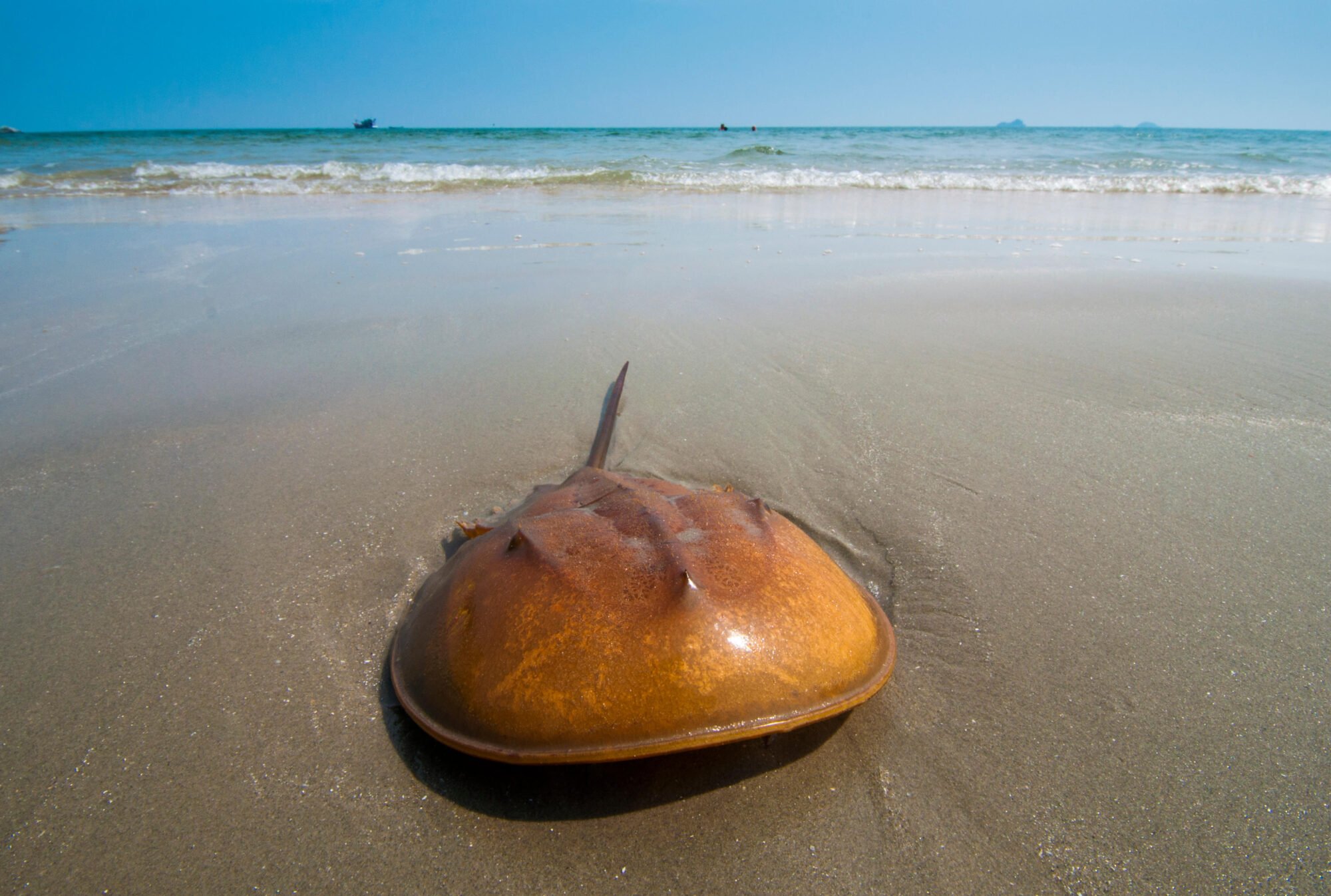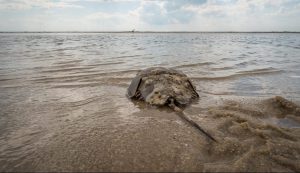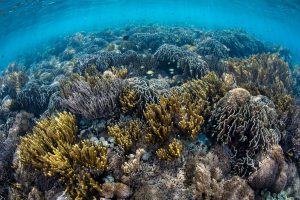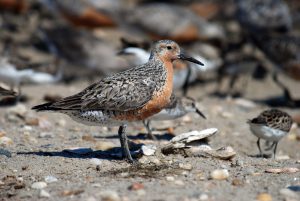On one day in June, the Guangxi Biodiversity Research and Conservation Association (GBRCA) freed 88 horseshoe crabs from the shores of Yuzhouping, in the Guangxi city of Fangchenggang. The crabs had been trapped in nets set by local fishermen, their tails caught tight and in some cases torn off.
Back in February, the two species caught at Yuzhouping, the Chinese horseshoe crab and the mangrove horseshoe crab, had been listed as Class II protected species.
These animals have existed for 400 million years, making them older than the dinosaurs. Their appearance and behaviour has changed little over those eons, and they have been described as “living fossils”. But reagents, known as LAL and TAL, extracted from the blue blood of Atlantic horseshoe crab and Chinese horseshoe crab respectively, can be used in quick and accurate tests for endotoxins during the manufacture of anything that might enter the human body, particularly medical equipment. Endotoxins are contaminants found in bacteria that can cause fever and in extreme cases death. Covid-19 has driven up demand for endotoxin testing, in order to make sure, for example, that needles are safe to deliver vaccinations.
Horseshoe crabs have a slow lifecycle, taking 10 years to reach maturity, and are expensive to raise. So, the blood needed for LAL/TAL manufacturing is collected from wild animals. Companies are expected to release the animals to the wild after taking blood, but the practice is poorly documented in China and is believed to cause a high death rate. The horseshoe crabs are also threatened by environmental damage and overfishing. Their populations have plummeted in Chinese waters over the decades.
The new Class II protected species status will at least restrain consumption of the horseshoe crab as food. It remains unclear, however, what the change will mean for production of TAL. Will the tougher protections save this ancient animal?
What will Class II status mean?
The Wildlife Protection Law sits at the top of China’s system of environmental legislation and regulation, providing protections for many rare wild animals. The List of Wildlife under Special State Protection, which encompasses Class II protected species, sits within the framework of the law. Inclusion on it can often be a turning point for the fate of an endangered species.
In the case of the horseshoe crabs, things could be a little more complicated.
Provincial-level protections for the animal were already in place in coastal provinces Fujian, Guangdong, Guangxi and Jiangsu. The effect of the shift to national protections depends on what was already in place in each province.
In Guangdong, Jiangsu and Fujian it was legal to fish for horseshoe crabs, as long as a permit from the county wildlife management authorities was obtained, and quotas were abided by. Now, those permits will need to come from the provincial authorities, making them harder to obtain, given the potentially higher scrutiny at that level of government.
But in Guangxi, the horseshoe crabs’ main habitat, provincial-level permits were already being issued in line with the requirements for Class II protected species. The change will therefore make little difference. Lin Wuying, a member of the International Union for Conservation of Nature (IUCN) Species Survival Commission’s horseshoe crab sub-group, thinks Guangxi may now be stricter with horseshoe crab quotas given the upgraded protection under the national law. “The fishery authorities may lower their quotas for the species. They’re also going to be tougher on which firms are allowed to catch the crabs, and won’t be handing out permits as easily as before.”

The change in conservation status means tougher penalties for illegal catches. In Guangdong and Jiangsu, the potential fines will now be higher. Even before the change, those found catching horseshoe crabs without, or in breach of, a permit, could see their catch, their fishing gear and any income confiscated, and permits revoked.
The Wildlife Protection Law makes allowances for the use of protected species in special circumstances, such as scientific research or medical use. This allows their trade and use, if permission is granted by provincial wildlife authorities. So use of horseshoe crabs for medicine will face a new type of supervision under its Class II protected status. In its 2018 Annual Report, Xiamen Bioendo Technology, a company that produces TAL reagents, said its suppliers had purchased and extracted blood from horseshoe crabs, but as the Chinese horseshoe crab was not then included on the List of Wildlife under Special State Protection, those suppliers neither needed, nor could apply for, permits. It is not yet clear what approach provincial authorities will take when handing out those permits in the new circumstances. In May, Caixin Weekly reported that authorities had not yet decided on policies for TAL producers, who would have to wait until the following month to make applications and find out how horseshoe crabs could be used under the new rules.
No sudden halt
Although the effects of the changes remain uncertain, companies have been quick to respond.
Two weeks after the update to the List of Wildlife under Special State Protection, Zhanjiang A & C Biological Ltd, one of China’s five largest TAL producers, published a press release saying it would halt supply of several products that required large quantities of horseshoe crab blood to make. The firm offered two new solutions, both of which use less blood.
After that press release was published, both Fuzhou Xinbei Biochemical Industry Ltd. and Xiamen Bioendo Tech stated they would continue to manufacture the products that Zhanjiang A & C Biological Ltd was discontinuing, but also research ways to reduce the use of horseshoe crab blood.

The use of LAL/TAL to detect bacterial endotoxins was pioneered in the US in the 1950s. In 1980, the method was included in the United States Pharmacopoeia, before being added to pharmacopoeias in Europe, Japan, the UK and China. It became a globally accepted test for endotoxins, and the healthcare industry has relied on horseshoe crab blood to ensure safety ever since.
Of the four existing horseshoe crab species, only the Chinese horseshoe crab and the Atlantic horseshoe crab are used to produce TAL and LAL. The Chinese horseshoe crab is found mainly on China’s southwest coast, while the Atlantic horseshoe crab is found on the eastern coast of North America. Currently, the IUCN’s Red List of Threatened Species lists the Atlantic horseshoe crab as “vulnerable” – the same category as the giant panda. The Chinese horseshoe crab is classed as “endangered”, meaning it is at risk of extinction.
According to an article in the journal of the National Audubon Society, a US environmental group, pharmaceutical firms carry out 70 million endotoxin tests a year, in a normal year. The vaccines and therapies being developed in response to the coronavirus pandemic mean demand has rocketed. And that means more horseshoe crab blood being used.
In China, the increased demand will clash with increased protections, and the industry is watching closely to see how conservation and healthcare will be balanced under the Wildlife Protection Law framework. There is only one line in the law about the use of wildlife in medicine. It states that use of wildlife or wildlife products in medicinal products must also abide by pharmaceutical laws and regulations. An industry expert who prefers to remain anonymous told China Dialogue this language is aimed at the use of wildlife in Chinese medicine, but horseshoe crab blood is being used to manufacture testing reagents – a different application. This means producing TAL from the blood may fall outside the framework of the law, so companies will probably be able to continue using it.
Blood transfusions?
What are the prospects for developing replacements? The pharmaceutical industry’s answer so far is not definitive.
Back in 2003, Jeak Ling Ding of the National University of Singapore used genetic engineering to produce Recombinant Factor C, or rFC, a substitute for horseshoe crab blood, one of several that have been developed around the world. An industry insider familiar with the matter told China Dialogue that while the properties of crab blood can vary across batches, rFC is more stable, more resistant to interferences, and can be supplied more sustainably. But rFC endotoxin testing remained relegated to an appendix in China’s 2020 Pharmacopoeia, meaning it is to be used when other methods are not available, rather than as an alternative of equal standing.
After Zhanjiang A & C Biological Ltd’s statement, the industry’s awareness of the problems associated with TAL testing rose, prompting increased sales of rFC products. With the horseshoe crab now protected, the industry is having to think seriously about alternatives.
Oversight still needed
Lin Wuying points out that while TAL reagents are still being used, more research into horseshoe crabs is needed to help set catch quotas; and governments need to do more monitoring of catches, usage and how companies return horseshoe crabs to the wild.
“The issuing of permits needs to be based on scientific research. We need to know how many crabs we can use. But currently there is a lack of such data.” Lin also told China Dialogue that there were small-scale surveys of horseshoe crab populations done in the 1970s and 1980s, with trawl nets used to bring them up for counting. But now the crabs are so scarce that, even using bigger nets, too few can be caught to calculate population size. Plus, trawling does damage to the seabed. The only research has been into population density of juvenile crabs and spawning rates in a limited number of regions, with that data then used to extrapolate to population figures. But those indirect methods are less reliable.

Various studies have found that even without their use in LAL reagent manufacturing, horseshoe crabs would be struggling to survive as they contend with land reclamation, coastal infrastructure construction, aquaculture and other habitat destruction.
The new Class II protection status means illegal catching of the crabs could result in jail time – but in practice, the kind of situation described at the start of this article is hard to police. Those nets weren’t designed to catch crabs, but nor do the fishers have any pressing reason to free them when they are caught accidentally. GBRCA, which has carried out its own monitoring and conservation of the species, has written that nobody is tackling illegal fishing in the intertidal zone, and research is needed to understand what impacts it is having, on what species, who the stakeholders are, and what can be done about it.








